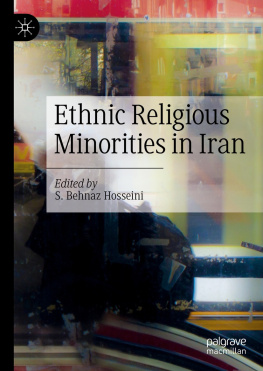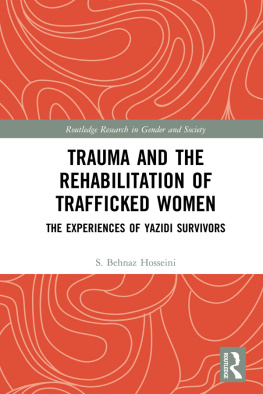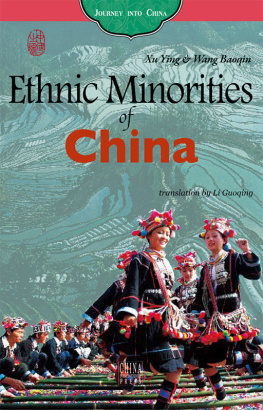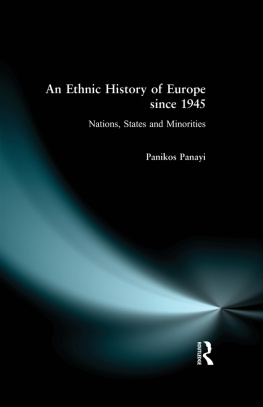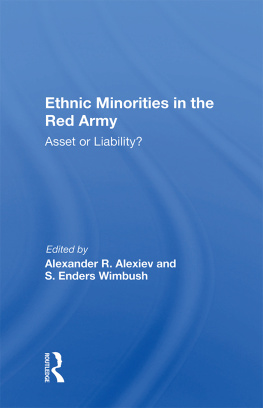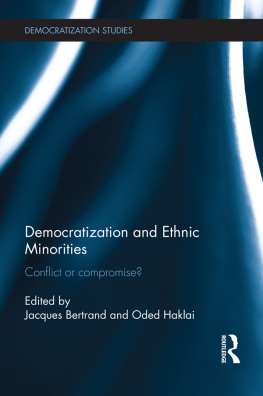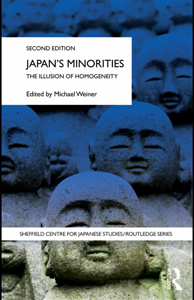Foreword: The Unacknowledged Religious Minorities in IranA Concise Conceptual Map
Introduction
In a country such as Iran, with the declared Shiite Islamic political system and with the majority of Muslims (99%), religion is a major element in social orientation. Islams arrival in Iran in the seventh century is a turning point in the countrys history. Since then, a complex combination of pre-Islamic and Islamic elements has been the salient character of Iranian identity. Furthermore, the strict distinction between in-group and out-group in Islamic doctrine made religious affiliation an essential foundation of social grouping. Safavid Shiization (1500s1700s ce ) replaced Islam as a broad concept with the sectarian Shiite denomination. The Shiite principle of Iranian identity became even more prominent after Irans Islamic Revolution (1979). Even though the Islamic Republic of Iran does not renounce the pre-Islamic principles of Iranian identity, it furthers the separation between pre-Islamic and Islamic principles in favor of the Islamic (Shiite) one. This process is represented tangibly in the building of the National Museum of Iran. The museum opened in 1937 and included mainly pre-Islamic objects. Later, in 1972, Islamic artifacts were added to the collection. However, fourteen years after the Islamic Revolution, in 1993, the museum was divided into two separate buildings: the Museum of Ancient Iran and, next to it, the Museum of Islamic Archeology and Art of Iran. The intrinsic antagonism of the two roots of Iranian identity, as is considered by the Islamic Republic of Irans official discourse, is represented in this divided National Museum.
Correspondingly, the definition of the minority in the Islamic Republic of Irans constitution is based on a Shiite perspective. In the constitution, Islam is the official religion of the country, and nowhere is Shiism named. Nonetheless, the Shiite tone of the text is easily recognized through the reiteration of Shiite concepts. Article 2 mentions immah (leadership) as the basis of the Islamic Republic system, and Article 5 assigns wal faqh (just and pious jurist) to the societys leadership during the occultation period of the twelfth Imam. As a result, based on their legal position, the religious minorities are divided into two categories: the legal minorities who are protected and their identity is acknowledged, and those whose identity is denied, and their legal position is ambiguous.
In this short piece of writing, I aim to portray an overview of Irans main religious and ethno-religious minorities in their relationship to the dominant political discourse of the country that can be served as a general conceptual map of the minorities.
The Acknowledged Minorities
The Zoroastrians, Jews, and Christians enjoy the liberty of practicing their religion and having representatives in the Islamic Parliament.
Despite the same legal position of Christians
Considering their historical presence, Jews are standing somewhere between the Zoroastrian indigenous community and the Armenian diasporic community. The Jews residence in Iran dates to the postexilic era when after they were released from Babylonian captivity (536 bce ), many stayed in the region under the Achaemenid sovereignty. Since then, the Iranian Jews have known no other actual homeland than Iran for more than two millennia. However, it is conceivable that the memory of a primordial homeland and the idea of the promised land have always been present in the collective memory of the people and may have affected their identification. Although the realization of the Jewish state of Israel (1948) is quite recent compared to the long history of Jews in Iran, it brings about some complexities in Iranian Jews identification, something that requires further studies. The official discourse of the Islamic Republic distinguished between the Jewish religion, and Zionism as the political ideology of Israel, a country that the Islamic Republic does not recognize. Iranian Jews speak standard Persian or other Iranian dialects with some Hebrew loanwords; however, Hebrew is almost completely liturgical. Having no obvious markers or symbolic means of separation such as distinct language makes them almost indistinguishable in the public and able to mingle with the majority in public.
The Outcasts
Categorizing the religions according to the strict Islamic-Shia Sharia is the foundation of the constitutional definition of the minorities; however, it doesnt cover the actual religious diversity of the country. Certain religious groups, more or less, fall out of the constitutional definition and consequently are derived into the realm of ambiguity and oblivion. Nonetheless, each of these religions has its own position in relation to the dominant political discourse, which has led their followers to be denied, suspected, or tolerated as second-class citizens.
Those Who Must Not Be Named
Khtimiyyat is a common belief among Muslims, which simply means that Islam is the last religion and the prophet of Islam is the last messenger of God. The Bahullhs challenged this conviction by claiming prophecy and declaring a new religion in nineteenth-century Iran. Bahaism emerged from the Iranian messianic movement of Babism that itself is rooted in the Shia belief of the hidden Imam. Expectedly, the emergence of a new religion sparked heated reactions among Shia

